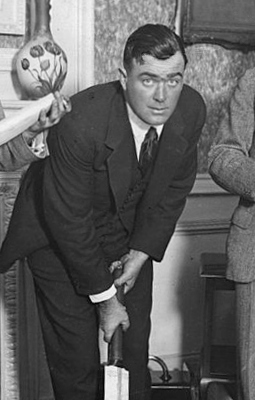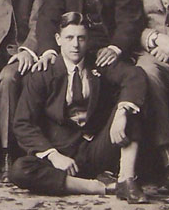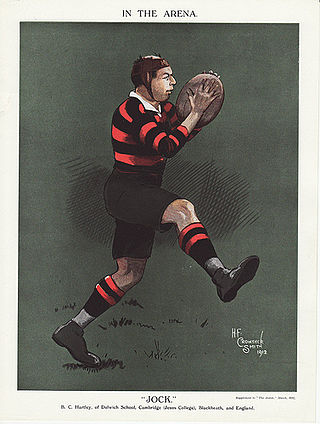Related Research Articles

The Fartown Ground or just simply Fartown is a sports ground located in the Huddersfield suburb of Fartown in West Yorkshire, England and is predominantly famous for being the home ground of Huddersfield Rugby League Club from 1878 to 1992. The grounds consisted of a rugby ground, a cricket ground used by Yorkshire County Cricket Club, Bowling greens and a running track as well as a pavilion. It was the scene of many great games, including the Challenge Cup finals of 1908 and 1910, several Challenge Cup semi finals, John Player Cup finals and international matches.

The Argentina national rugby union team represents Argentina in men's international competitions, The Argentine Rugby Union. Officially nicknamed Los Pumas, they play in sky blue and white jerseys. They are ranked 5th in the world by World Rugby, making them by some distance the highest-ranked nation in the Americas.

Reginald Erskine Foster, nicknamed Tip Foster, commonly designated R. E. Foster in sporting literature, was an English first-class cricketer and footballer. He is the only man to have captained England at both sports.

Thomas Coleman Lowry was a New Zealand international cricketer. He was New Zealand's first Test captain, and led the team in their first seven Test matches between January 1930 and August 1931. He played first-class cricket from 1918 to 1937. He was a farmer and racehorse breeder in Hawke's Bay, who served as president of the New Zealand Thoroughbred Breeders Association from 1951 to 1965.
The Old Alleynian Football Club is an open rugby union club founded as a team for the old boys of Dulwich College, themselves known as Old Alleynians. Founded in 1898, it is one of the oldest clubs in London and was the last of London's old boys clubs to become a fully open club. It is notable not only for its longevity, but also for the prominence it once attained on the club circuit and for the number of eminent players that have been members of the club, some of whom gained their international caps whilst at the club.

John McIllwaine Moore "Mick" Commaille was a South African cricketer who played in 12 Tests from 1909–10 to 1927–28. He also played international amateur football for South Africa.
Humphrey Seymour Ramsay Critchley-Salmonson, born at Preston in Dorset on 19 January 1894 and died at Ottery St Mary, Devon on 24 April 1956, played first-class cricket intermittently over an 18-year period for Somerset. He later played two first-class matches for Sir Julien Cahn's XI in Argentina.

John Edward Raphael was a Belgian-born sportsman who was capped nine times for England at rugby union and played first-class cricket with Surrey. He was a Barrister by profession and a Liberal politician.

George Aldwyn Methuen Isherwood (1889-1974) was a rugby union international who was part of the first official British and Irish Lions team that toured South Africa in 1910.

Charles Young Adamson was an English international rugby union utility back who played club rugby for Durham. Adamson played international rugby for the British Isles team on its 1899 tour of Australia. Adamson was also a gentleman cricketer, playing mainly for Durham City. After the 1899 rugby tour, he remained in Brisbane playing for the Valley District Cricket Club and turned out for a single cricket match for Queensland, as well as playing in Durham's first Minor Counties Championship match in 1895. He played for Durham until 1914.

Alexander Findlater Todd was an English rugby union forward who played for Cambridge University and Blackheath F.C. at club level, and Kent at county level. Todd played international rugby for England and later represented the British Isles team on their 1896 tour of South Africa.

William Ralph Martin-Leake was an English rugby union forward who played club rugby for Cambridge University and Harlequins and international rugby for England. In 1890 Leake became one of the original members of the Barbarians.
Ian Douglas Freeman Coutts was a Scottish sportsman from England who played cricket at first-class level and who represented Scotland in rugby union from 1951 to 1952.

Major Bernard Charles "Jock" Hartley OBE was a rugby union international player who represented England from 1901 to 1902. At club level he represented Cambridge University and Blackheath. In 1938 he was given the role of team manager of the British Isles team on their tour of South Africa.
Frederic Alexander Waldock played first-class cricket for Oxford University and Somerset between 1919 and 1924, and then for representative sides in his native Sri Lanka between 1927 and 1934. He was born at Colombo, Sri Lanka and died at Galmington, Taunton, Somerset.
Lennox Football Club was an English 19th century rugby union football club that disbanded in the early twentieth century. It is notable for producing a number of international players and for its role in the Rugby Football Union fight against professionalism.

Edward Newman Fuller (1888–1969) was an English sportsman who played rugby union at an international level, touring Argentina with the 1910 Combined British rugby union side, an early incarnation of the British & Irish Lions.

Vivian Frank Shergold Crawford was an English cricketer who played as a right-handed batsman and an occasional right-arm fast bowler in first-class cricket for Surrey and Leicestershire between 1896 and 1910. He also played for many amateur teams. He was born in Leicester and died at Merton, Surrey. He was the brother of the England Test cricketer Jack Crawford and of the Leicestershire first-class cricketer Reginald Crawford.
References
- 1 2 Carlos Mold Profile on scrum.com
- 1 2 Charles Mold at cricketarchive.com
- ↑ War Office: Soldiers’ Documents, First World War ‘Burnt Documents’ (Microfilm Copies); (The National Archives Microfilm Publication WO363); Records created or inherited by the War Office, Armed Forces, Judge Advocate General, and related bodies; The National Archives of the UK (TNA), Kew, Surrey, England.
- ↑ match list at cricketarchive.com Archived June 4, 2011, at the Wayback Machine